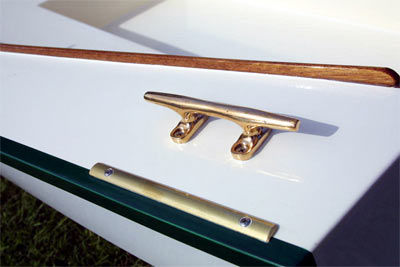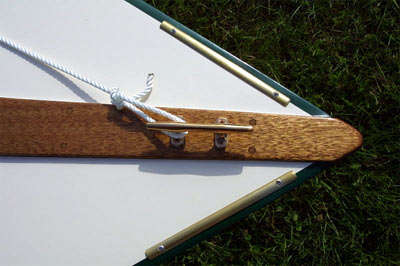Painting your
boat is important since it is the paint or varnish finish that
people see. They do not see the many hours of building. They
see smooth paint. So how do you get that perfect paint job?
Read online or all the books you can get. I like Sam Devlin's
book, it will help a lot. There is no one
right answer to this subject. Talk to other builders whose work
you like. Ask them how they paint. This is what works for me.
The basic way you get a spectacular paint or varnish finish
is really good preparation. Its not all that hard to get nice
glossy yacht paint on smoothly but what kills the look is
bad or not enough prep. Most guys wimp out at that stage.
I say boat building is 50% sanding. You will need to get into
the "zen of sanding". Sand until you want to stop.
Then come back later and repeat. Keep at it until the surface
is perfect. that's the zen of it. Sanding epoxy and glass
fair and smooth will take longer than bare wood. Depends on
what you are building and how you want to finish it. Work
boat or show boat or somewhere in the middle. Do what will
make you happy and proud. Do what makes YOU smile. Show boat
finish will be more work to do and more work to maintain.
To me, a good finish is just as important as the building.
So I do as good a job as I can on the sanding and finish work.
Your surface should be smooth and fair with sanding done to
at least 220 before you start painting.
If painting, use a good primer - not one that "sands
easily" or contains talc. They absorb water and are soft
- not a good thing under boat paint. The primer will not be
glossy and will help you see what work still needs to be done.
It will let you see little imperfections need a bit of filler.
That’s why I use primer. Technically you don’t
need it to get most paint to stick to epoxy so if you are
painting a boat that is glassed and epoxy encapsulated you
can skip the primer. For filler I like the 3M Marine Putty.
Sets fast and sands nice.
Super smooth boat show like finishes were probably sprayed
(over perfect prep) or actually polished like they do classic
cars. Very fine sandpaper up to grits like 2000 and then buffed
with ever finer grades of polishing compounds. You need lots
of paint on to do that. You also need a very clean shop and
the ability to control access to it. In other words - once
the paint or varnish coat is on - no one enters the shop to
stir up dust etc until the coat is dry to the touch. Not even
the painter to sneak a look! If you are not in the shop you
won’t stir up dust bunnies or be tempted to try to “fix”
that little flaw in the paint an hour later causing even more
trouble.

Paint selection is also an issue. Devlin has lots to say
about that. You will not be able to use the 2 part linear
urethanes like he does without ALL the safety equipment. So
you will be using 1 part boat paint or maybe the new water
base linear poly from System 3. Neither are as glossy as the
linear. Interlux Brightsides is very glossy and turns out
a nice finish. Petit EasyPoxy has loyal fans. Some guys use
exterior porch paint or equipment enamel with good results.
The one part paints are all mostly alkyd enamel with various
amounts of polyurethane added. They are not true polys. Also
the Wooden Boat Mag forum guys seem to like the Kirby Paint.
Made for boats. I have not used it. Some guys like and use
plain old house paint on their boats. It works but I don’t
like the way it looks. On a kids knockabout skiff it would
be perfect. Let them bang it up and slap more paint on it.
Porch paint seems to be a nice middle ground between the marine
paints and house paint. The Glidden brand has worked for me
and since it has a tint base it can be mixed in just about
any color you want.
Normally no clear coat of any kind is used. Too hard to repair
and touch up. The only one I have seen for boats is the System
3 clear coat to go over their water base linear (for more
gloss). I would talk to them before I used it over another
brand of paint. Do not use lacquer any where near a boat.
It is not water resistant at all. Cabinet guys like it since
it dries really fast and levels nicely. They can get lots
of shiny coats on in one day and be done.
If not spraying then use rollers for any large areas. Brushes
for small areas or detail work. If you use the right rollers
and tip the paint you can get a sprayed on finish look with
little or no roller texture.
I don't have problems with Brightsides but it does have a
reputation of being hard to apply. Like most marine paints
it is thin and prone to runs, sags and drips. It is so glossy
that it shows every imperfection. This means it demands very
good prep. Most builders are in such a hurry to get the boat
in the water they skimp on prep. Prep means fair surfaces
and smooth sanding. Prep means time. My “Zen of Sanding”
concept already discussed.
Paint needs to go on in thin coats. I don't think you can
successfully brush it on large surfaces. Brushes leave too
much paint. Use the white foam rollers (4", round ends)
at Home Depot or Lowe’s. Use paint filters and filter
every batch you put in the roller pan. Do NOT put the unused
paint back in the can since it has lost solvent and will affect
the rest of the can and your future results. So don’t
put half a quart in the roller pan. Carefully roll it on thinly
and evenly like you would use any roller on any paint but
finish each section by rolling like you were using a brush.
That means rolling one direction only - dry to wet. Note
that the rollers seem to have a grain - one direction will
leave more bubbles than the other so flip the roller to check.
Do a few sections (2 - 3 square feet each) then tip by using
a second dry roller. No pressure just the weight of roller.
All you are trying to do is pop any bubbles. The warmer it
is then the faster you need to work or the smaller the sections
need to be.

Have good light and really look at each section as soon as
you are done with your final rolling. Check for anything you
don't like. Now is the time to fix it then do the final roll
again. Once you have tipped DO NOT TOUCH IT AGAIN. Brightsides
sets fast but takes a long time to get hard. It levels well
for the same reason it sags and drips and runs. The idea is
to get just enough paint on to be glossy and wet but not too
much. Too little applied will leave the grain of the roller
in the surface. Easy to see when you are checking for imperfections
at the end of each paint section. If it runs or sags after
you have tipped just sand it out later. Note that you can
sometimes “hear” that you have too much paint
on by the way the roller sounds when doing your final rolling.
Too much paint will also tend to bubble more.
If you have trouble with the paint not leveling or it sets
too fast then add a couple of ounces of Penetrol to the paint.
It will help it flow better and delay the “set”
time so you keep a wet edge longer. Penetrol won’t delay
the dry time (when you start sanding). I always use it in
varnish but not always in paint. Depends on the temperature
of the shop that day.
Sand between coats with fake steel wool by 3M - finest grade
you can get. Wet sand every second or 3rd coat with 400 grit.
Anything coarser is for paint salesmen. This will build coating
thickness faster and still give you a good smooth paint job.
Do not use solvents of any kind to clean up after sanding.
Shop vac with a brush then wipe with clean lint free cloths.
No tack rags. When you wet sand rinse with clean water before
letting it dry.
The nice thing about painting lots of coats is that you get
to practice. Only the last coat shows. The rest get sanded
and all your learning happens with the primer and base coats
of paint.
Now stand back and smile. Be sure to post a picture on Duckworks!

